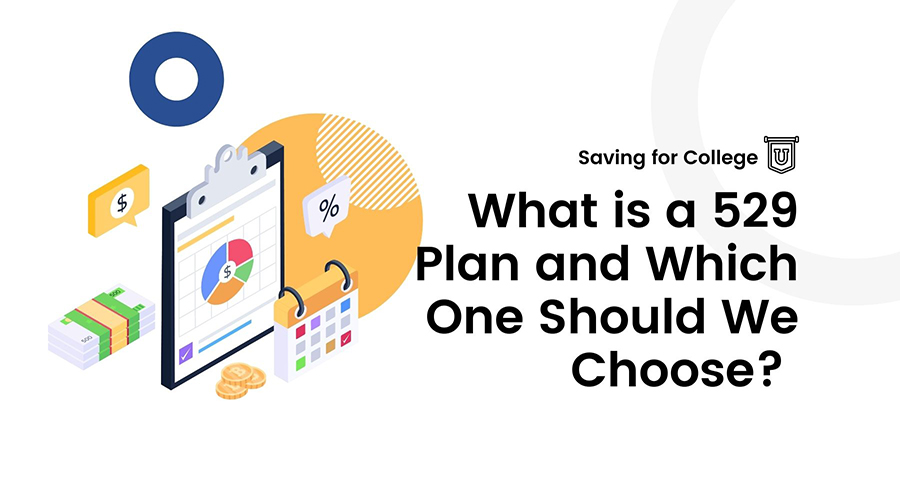Saving for College with a 529 Account

Whether your children are infants or just a year or two away from college, you are likely thinking about saving for college. I get it! I have three kids that will likely go on to some form of higher education post-high school. It’s expensive and that cost is only going up between now and when they start. For me, a 529 plan is a great way to save.
What’s so great about a 529 account?
It’s an investment account that helps you save for future educational expenses. When you put money in and invest it, any investment earnings are free of federal tax. When you take money out and use it for Qualified Education Expenses, you won’t pay any federal taxes on those withdrawals. Depending on the state where you live and the 529 plan you choose, the qualified withdrawals may not be taxed by the state either.
The definition of “Qualified Education Expenses” is pretty broad, so in addition to tuition it also includes things like books, supplies, room, and board for both on-campus and off-campus students while they’re enrolled at least half-time. Always check with the college though, because the amount can’t go over the institution’s published “cost of attendance” allowance. A student can use 529 account money for a bachelor’s or associate degree, as well as graduate-level or professional degrees.
And it’s not just limited to college. You can use up to $10,000 a year per student for tuition at a K-12 public, private or religious school. Your 529 account can also be used to pay for some vocational and apprenticeship programs. We’ll talk more about that in Question 5 below. You can even use a lifetime maximum of $10,000 to help pay off the student’s qualified education loan or their sibling’s qualified education loan. I’m going to go ahead and say it here, but it’s important to remember at all stages: How the state taxes work for these kinds of withdrawals varies from state to state, so it’s always a good idea to check with the 529 plan and your tax advisor.

Which 529 plan should I choose?
Although you’re not required to use your own state’s 529 plan, there may be some extra tax advantages to doing so. For example, if you’re a Georgia taxpayer and you choose the Georgia Path2College 529 Plan, your contributions into the plan are deductible up to $8,000 per year per beneficiary for joint filers, or $4,000 per year per beneficiary for all others.(1)
In addition to the potential state tax treatment of contributions and withdrawals, there are a lot of other variables to consider. Can you enroll directly or do you need to go through a financial advisor? What about enrollment fees or contribution limits? Some states, like Florida, require the beneficiary or the parent to be a resident of the state for 12 months before opening the account (2). One helpful online comparison tool for 529 plans is Saving for College,(3) which allows you to filter on different criteria and look at the plans side by side to help you determine the best fit for you.
Choosing one state’s 529 plan doesn’t mean your child has to go to college in that state. If you choose the Virginia plan your student can still go to college in California. The 529 money can be used at most accredited colleges and universities around the US, and even some colleges abroad. You can visit Ed.gov (4) to see if the post-secondary school is accredited or ask the school’s Financial Aid Office for more details.
Who can open a 529 account?
Most plans require the owner to be a US citizen or resident alien who is at least 18 years old. For each account there’s one owner (usually a parent or grandparent) and one beneficiary (the student). Many plans allow the owner to name a successor owner who can take over the account if the original owner dies. If you’re a parent with 3 children you’ll want to open 3 accounts – one for each child. As an adult, you can open up an account for yourself, where you’re both the owner AND the beneficiary.
Once the account is open, anyone can contribute to it. This means grandparents, parents, aunts, uncles, friends, etc. Most plans have fairly high plan balance maximums (in the $200,000 – $520,000 range for each beneficiary) so there’s a lot of room for generosity!
How should I invest the account once it’s opened?
As you might imagine, there’s no one-size-fits-all answer to this. One of the most important things to think about is this: “How long before my student needs the money?” If you’re opening an account for your 10 year old daughter, her money will probably be invested for less time than your son who’s 2 years old. With a younger student you might be able to tolerate a more aggressive investment strategy because college is further down the road. With a slightly older student you’d still want the money to grow, but not take too much risk of losing it right before she needs it. Because this is an investment account, the money isn’t guaranteed or insured and there are always inherent risks.
Most plans offer a range of investment strategies, from conservative to aggressive. If you don’t feel comfortable being the one in charge of picking and adjusting the strategies over time, then a target-date fund might be your best option. This strategy is based on the student’s anticipated high school graduation year. When that date is far off, the fund is more growth oriented. As the student approaches high school and the date gets closer, the strategy automatically adjusts to a more conservative investment mix. If you have multiple children with spread out ages (my blended family has six kids who range from 7 to 24!), then each of them might end of up with a different target date fund.
Every 529 plan’s website has links to the plan’s investment choices and performance information, which is usually called the Plan Description. It’s there you can see the choices, costs, information about the investment managers, as well as how each strategy has performed in the past. You should definitely take time to look it over before making a decision. Just keep in mind that how it performed in the past doesn’t guarantee how it will do in the future, right?
What if my child decides not to go to college?
College isn’t for everyone. If your student decides to go to a vocational institution or enter an apprenticeship, she may still be able to use the 529 plan funds for tuition, books, supplies, and equipment. The vocational institution must be eligible to participate in a student financial aid program under Title IV of the Higher Education Act. You can look up the Federal School Code Search (5) or contact the school directly to see if they’re eligible. If it’s an apprenticeship, the program must be registered and certified with the Secretary of Labor under the National Apprenticeship Act. You can find more information about these programs here (6).
You can also change beneficiaries along the way. If one child needs more than the other, you can transfer 529 funds to another family member’s 529 account. You can also change the beneficiary on the account as long as the new beneficiary is a family member. In this situation, family includes siblings (including step siblings), parents, children, first cousins, and nieces/nephews.
If you decide to use the money for something else altogether or close out the account, any earnings that are not used for “Qualified Educational Expenses” are subject to federal taxes (and maybe state taxes, too). There might also be a 10% federal tax penalty, although some exceptions may apply for death, disability, or scholarships.
If you have more questions about 529 accounts or saving for your child’s or grandchild’s education, feel free to call our office at 770-471-6674 or email me at Christal.White-Stevens@onpurposefinancial.com. The office for On Purpose Financial Management is located at 101 Devant Street, Ste 903 Fayetteville, GA 30214.
Sources & Links:
- Source: www.path2college529.com
- Source: https://www.myfloridaprepaid.com/savings-plan/faqs/
- Link: https://www.savingforcollege.com/compare-529-plans
- Link: https://www.ed.gov/accreditation?src=rn
- Link: www.studentaid.gov/fafsa-app/FSCsearch
- Link: https://www.apprenticeship.gov/employers/registered-apprenticeship-program
Please note, changes in tax laws or regulations may occur at any time and could substantially impact your situation. While we are familiar with the tax provisions of the issues presented herein, as Financial Advisors of RJFS we are not qualified to render advice on tax or legal matters. On Purpose Financial Management is not a registered broker/dealer and is independent of Raymond James Financial Services. Investment advisory services are offered through Raymond James Financial Services Advisors, Inc.
Investors should carefully consider the investment objectives, risks, charges and expenses associated with 529 college savings plans before investing. More information about 529 college savings plans is available in the issuer’s official statement. The official statement is available through your financial advisor, and should be read carefully before investing. Before investing, it is important to consider whether the investor’s or designated beneficiary’s home state offers any state tax or other benefits that are only available for investments in such state’s qualified tuition program.
As with other investments, there are generally fees and expenses associated with participation in a 529 plan. There is also a risk that these plans may lose money or not perform well enough to cover college costs as anticipated.
